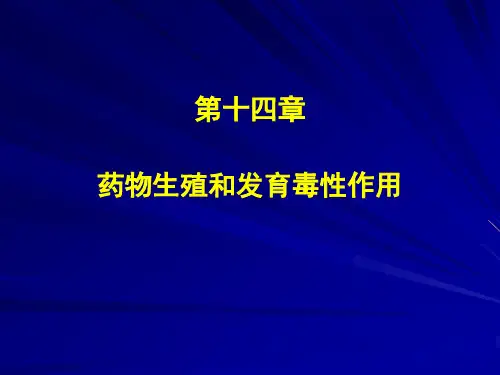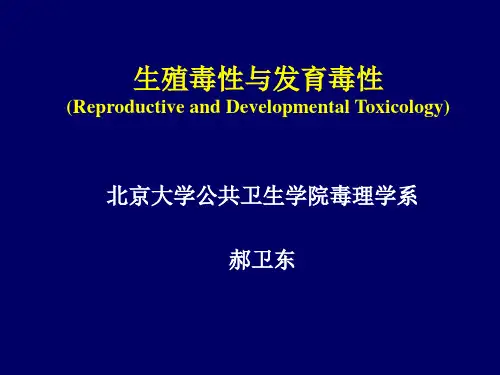一般生殖毒性试验方法原则
- 格式:ppt
- 大小:2.38 MB
- 文档页数:48
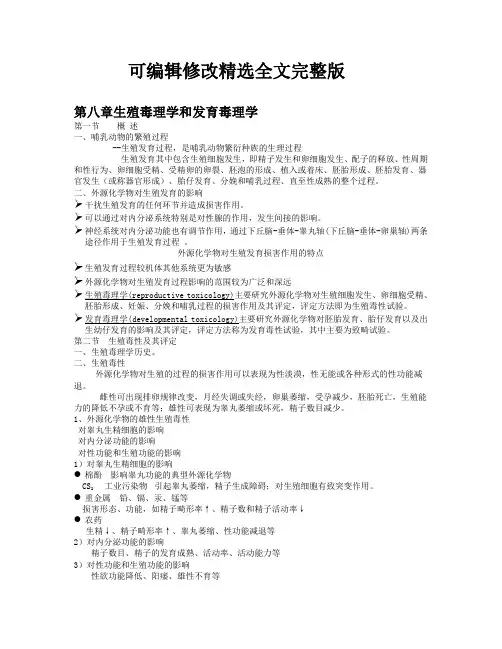
可编辑修改精选全文完整版第八章生殖毒理学和发育毒理学第一节概述一、哺乳动物的繁殖过程--生殖发育过程,是哺乳动物繁衍种族的生理过程生殖发育其中包含生殖细胞发生,即精子发生和卵细胞发生、配子的释放、性周期和性行为、卵细胞受精、受精卵的卵裂、胚泡的形成、植入或着床、胚胎形成、胚胎发育、器官发生(或称器官形成)、胎仔发育、分娩和哺乳过程、直至性成熟的整个过程。
二、外源化学物对生殖发育的影响➢干扰生殖发育的任何环节并造成损害作用。
➢可以通过对内分泌系统特别是对性腺的作用,发生间接的影响。
➢神经系统对内分泌功能也有调节作用,通过下丘脑-垂体-睾丸轴(下丘脑-垂体-卵巢轴)两条途径作用于生殖发育过程。
外源化学物对生殖发育损害作用的特点➢生殖发育过程较机体其他系统更为敏感➢外源化学物对生殖发育过程影响的范围较为广泛和深远➢生殖毒理学(reproductive toxicology)主要研究外源化学物对生殖细胞发生、卵细胞受精、胚胎形成、妊娠、分娩和哺乳过程的损害作用及其评定,评定方法即为生殖毒性试验。
➢发育毒理学(developmental toxicology)主要研究外源化学物对胚胎发育、胎仔发育以及出生幼仔发育的影响及其评定,评定方法称为发育毒性试验,其中主要为致畸试验。
第二节生殖毒性及其评定一、生殖毒理学历史。
二、生殖毒性外源化学物对生殖的过程的损害作用可以表现为性淡漠,性无能或各种形式的性功能减退。
雌性可出现排卵规律改变,月经失调或失经,卵巢萎缩,受孕减少,胚胎死亡,生殖能力的降低不孕或不育等;雄性可表现为睾丸萎缩或坏死,精子数目减少。
1、外源化学物的雄性生殖毒性对睾丸生精细胞的影响对内分泌功能的影响对性功能和生殖功能的影响1)对睾丸生精细胞的影响●棉酚影响睾丸功能的典型外源化学物CS2 工业污染物引起睾丸萎缩,精子生成障碍;对生殖细胞有致突变作用。
●重金属铅、镉、汞、锰等损害形态、功能,如精子畸形率↑、精子数和精子活动率↓●农药生精↓、精子畸形率↑、睾丸萎缩、性功能减退等2)对内分泌功能的影响精子数目、精子的发育成熟、活动率、活动能力等3)对性功能和生殖功能的影响性欲功能降低、阳痿、雄性不育等2、外源化学物的雌性生殖毒性●对卵细胞的影响●对内分泌的影响●对子代生长发育的影响环境因素尤其是化学物工业污染物、农药、重金属、毒素等三、生殖毒性的评价外源化学物对生殖过程作用的评定主要通过生殖毒性试验来进行。

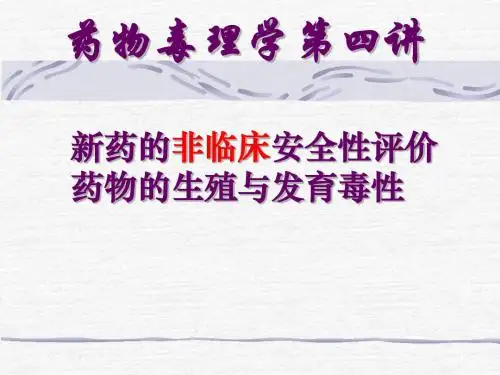

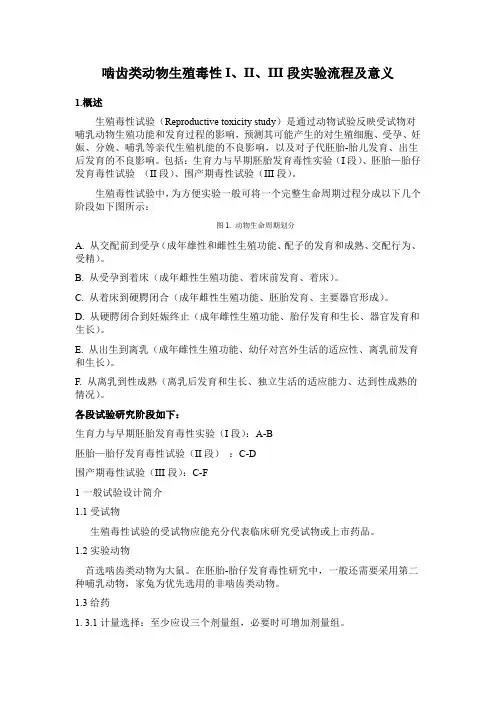
啮齿类动物生殖毒性I、II、III段实验流程及意义1.概述生殖毒性试验(Reproductive toxicity study)是通过动物试验反映受试物对哺乳动物生殖功能和发育过程的影响,预测其可能产生的对生殖细胞、受孕、妊娠、分娩、哺乳等亲代生殖机能的不良影响,以及对子代胚胎-胎儿发育、出生后发育的不良影响。
包括:生育力与早期胚胎发育毒性实验(I段)、胚胎—胎仔发育毒性试验(II段)、围产期毒性试验(III段)。
生殖毒性试验中,为方便实验一般可将一个完整生命周期过程分成以下几个阶段如下图所示:图1. 动物生命周期划分A. 从交配前到受孕(成年雄性和雌性生殖功能、配子的发育和成熟、交配行为、受精)。
B. 从受孕到着床(成年雌性生殖功能、着床前发育、着床)。
C. 从着床到硬腭闭合(成年雌性生殖功能、胚胎发育、主要器官形成)。
D. 从硬腭闭合到妊娠终止(成年雌性生殖功能、胎仔发育和生长、器官发育和生长)。
E. 从出生到离乳(成年雌性生殖功能、幼仔对宫外生活的适应性、离乳前发育和生长)。
F. 从离乳到性成熟(离乳后发育和生长、独立生活的适应能力、达到性成熟的情况)。
各段试验研究阶段如下:生育力与早期胚胎发育毒性实验(I段):A-B胚胎—胎仔发育毒性试验(II段):C-D围产期毒性试验(III段):C-F1一般试验设计简介1.1受试物生殖毒性试验的受试物应能充分代表临床研究受试物或上市药品。
1.2实验动物首选啮齿类动物为大鼠。
在胚胎-胎仔发育毒性研究中,一般还需要采用第二种哺乳动物,家兔为优先选用的非啮齿类动物。
1.3给药1. 3.1计量选择:至少应设三个剂量组,必要时可增加剂量组。
高剂量:应出现一些轻微的母体毒性反应,或为最大给药量/最大耐受量。
低剂量:应为生殖毒性方面的“未观察到不良反应的剂量(NOAEL)”。
1.3.2给药途径:给药途径应与临床拟用途径一致(不用腹腔注射途径,因腹腔注射会对胎儿及子宫产生直接影响)。
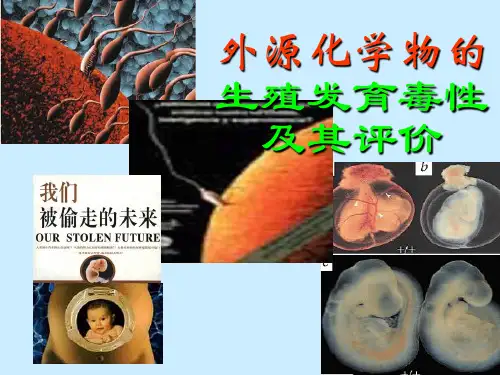

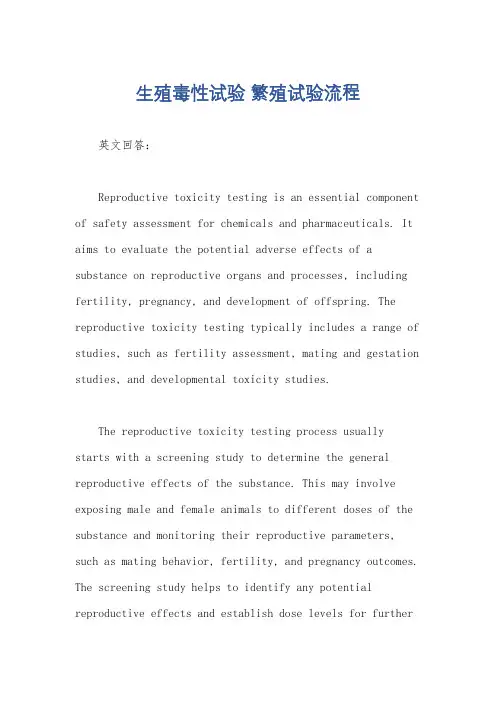
生殖毒性试验繁殖试验流程英文回答:Reproductive toxicity testing is an essential component of safety assessment for chemicals and pharmaceuticals. It aims to evaluate the potential adverse effects of a substance on reproductive organs and processes, including fertility, pregnancy, and development of offspring. The reproductive toxicity testing typically includes a range of studies, such as fertility assessment, mating and gestation studies, and developmental toxicity studies.The reproductive toxicity testing process usuallystarts with a screening study to determine the general reproductive effects of the substance. This may involve exposing male and female animals to different doses of the substance and monitoring their reproductive parameters, such as mating behavior, fertility, and pregnancy outcomes. The screening study helps to identify any potential reproductive effects and establish dose levels for furtherstudies.Following the screening study, more detailed reproductive toxicity studies are conducted. These studies often involve exposing animals to the substance during specific stages of reproduction, such as pre-implantation, organogenesis, or lactation. The effects on fertility, pregnancy, and development are carefully monitored and assessed. For example, in a developmental toxicity study, pregnant animals are exposed to the substance and evaluated for any adverse effects on fetal growth, development, and survival.In addition to the reproductive parameters, other endpoints such as hormonal changes, histopathological examination of reproductive organs, and genetic toxicity may also be evaluated. These endpoints provide valuable information on the mechanisms of reproductive toxicity and help in the overall risk assessment of the substance.Reproductive toxicity testing is guided byinternational guidelines, such as those developed by theOrganization for Economic Co-operation and Development (OECD). These guidelines provide standardized protocols and criteria for conducting and interpreting the results of reproductive toxicity studies. Compliance with these guidelines ensures the reliability and comparability of the data generated across different laboratories and countries.中文回答:生殖毒性试验是化学品和药物安全评估的重要组成部分。
